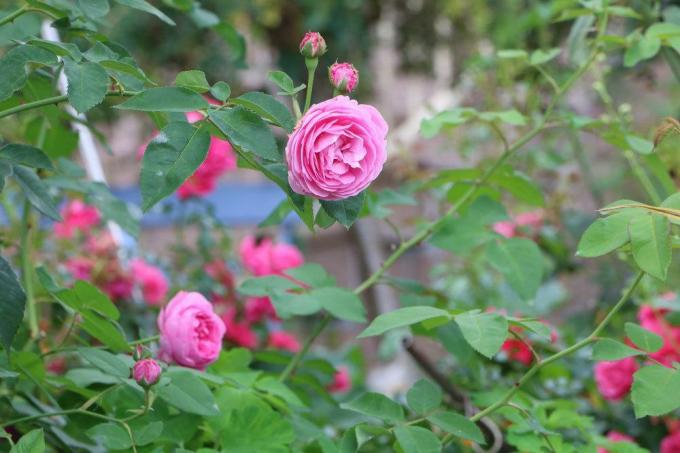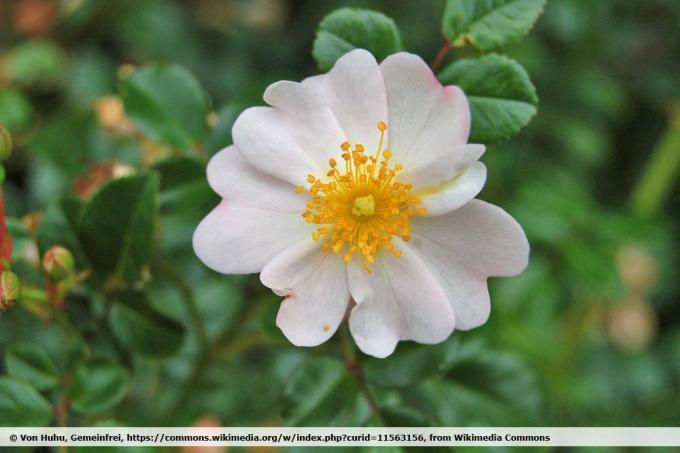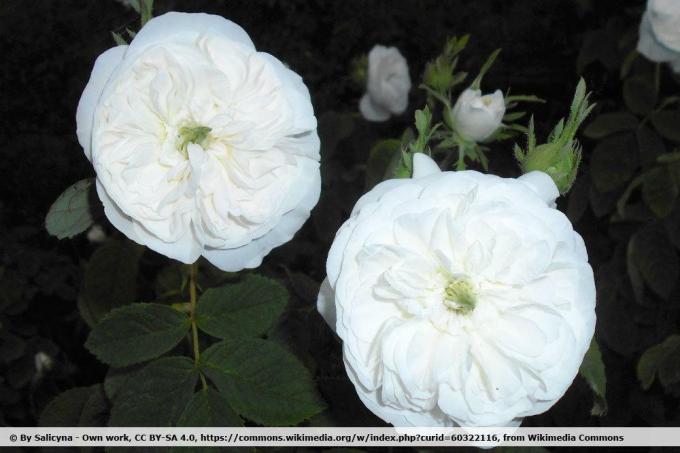
table of contents
- 30 varieties of scented roses
- care
- Location
- floor
- plants
- Substrate
- Repot
- Watering & fertilizing
- Cut
- Overwinter
- Pests and diseases
Scented roses represent a special group of roses which, compared to other varieties, exude a bewitching scent. These are not just shrub roses, but climbing, small shrub and park roses with varying aromas and nuances. They are cultivated either as varieties planted outdoors or as tub roses. In addition to the location, good care is also important for a fragrant bloom, which supports the plants in growing and blooming.
30 varieties of scented roses
Real fragrant roses only make up a small part of the large variety of varieties of the genus Rosa. However, except for special cultivars, all of them smell Wild roses, but even here only certain species are so intense that they are specifically due to humans Their scent is planted or used, for example, for the production of perfumes or cosmetics will. One of the most important hybrids of all, which is also used as the basis for many fragrant roses, is the Damascus rose. The Damascus (Rosa damascena) is a (possible) cross between Rosa moschata and Rosa gallica or Rosa gallica and Rosa phenicia, which have been specially cultivated since ancient times for their intense fragrance will. But that's not the only type of rose that is used for scented roses:
- Vinegar rose (bot. Rosa gallica)
- Bourbon rose (bot. Rosa borboniana)
- Musk rose (bot. Rosa moschata)
- White peasant roses (bot. Rosa alba)
Together there are five types that make aromatic beauties possible for your garden or tub. The fragrance strength ranges from pleasant to beguiling and even heavy, which determines the use for large or small green oases up to the balcony. When looking for suitable scented roses, you should take a look at the list below. 30 of the most popular scented rose varieties are listed in this:
- Acapella: hybrid tea
- Astrid Countess von Hardenberg: shrub rose
- Augusta Luise: Hybrid Tea
- Bobbie James: Rambler Rose
- Blue Parfum: floribunda rose
- Charles Austin: Shrub Rose
- Colette: shrub rose
- Constanze Spry: English rose
- Scented gold: hybrid tea
- Scented rush: hybrid tea
- Fragrance cloud: hybrid tea
- Erotica: Hybrid Tea
- Frederic Mistral: Hybrid Tea
- Fritz Nobis: tub rose
- Spring gold: shrub rose
- Guirlande d ‘Amour: Rambler rose
- Hercules: shrub rose
- Isarperle: floribunda rose
- Jacque Cartier: Park Rose
- Kiftsgate: Rambler Rose
- Queen of Denmark: park pink
- Laguna: climbing rose
- Medeo: ground cover rose
- Michelangelo: Hybrid Tea
- Mme Hardy: Historic rose
- Othello: English rose
- Rose de Resht: tub rose
- Senteur Royale: tub and hybrid tea rose
- Waterloo: Historical Rose
- Westerland: shrub rose

Note: If the care of the fragrant rose varieties is successful, you can leave the blossoms even make your own aromatic oils. These are ideal for use in your own perfumes, room fragrances, cosmetics or for relaxation as aromatherapy.
care
Regardless of which of the mentioned scented roses you choose, the care of the plants always works in the same way, apart from the smallest differences. It is important to take good care of the pinks, as otherwise the fragrant plants will develop few flowers, which in turn has a negative effect on the fragrance performance. The more flowers, the more intense the scent. At the same time, many or healthy flowers mean that the formation of essential scented oils is increased, which of course affects the intensity and nuances of the scent. You can find out which care measures are required for scented roses in the following sections.
Location
The location is particularly important for fragrant rose varieties. This is because, in addition to the nature of the soil and substrate, this noticeably contributes to the formation of flowers and the production of essential oils inside the plant. In addition, the right location strengthens the vitality of the rose, which has a positive effect on the resistance to pests and diseases. The rose location should have the following characteristics:
- Light requirement: sunny to shady
- Partial shade is tolerated
- no direct sun over midday
- ideal points of the compass: southeast, southwest
Place the rose varieties so that they are not too close to other specimens or plants. Because the plants need a lot of fresh air so that excess moisture can dry quickly through rain. This prevents fungal infestation in particular. If you plant the roses outdoors, you don't even have to worry about strong winds, as the dense rose growth will withstand them. With container plants, however, you have to be a little more careful so that the container is not blown over. Balconies are quite suitable if the sun doesn't shine over midday.
tip: Never plant the fragrant beauties under trees or roofs from which it can rain on the plants. Because this increases the risk of damage from the high humidity, which in turn can severely limit the formation of flowers.

floor
In addition to the location, the soil is another element that you need to adapt precisely to the conditions of the plant. Since roses are difficult to transplant, the soil should have appropriate properties so that the rose can easily establish itself:
- sandy
- humus
- low in salt
- low in acid
- pH value: 5.5 - 7.0
- permeable
- loamy
In the case of the soil, it is only important that there is no waterlogging and that sufficient nutrients are available. You have to keep this in mind when planting.
plants
Planting scented roses cannot be done without preparing the soil. This must be adjusted so that the pinks feel comfortable and quickly establish themselves. It is planted in the following way:
- Time: autumn before the frost
- Water the ball of the rose
- Cover with water up to the finishing point
- Shorten the roots to 20 cm
- remove damaged, dead, or rotten roots
- Dig the planting hole
- Plant hole size: 50 cm diameter, depth corresponds to roots
- Use drainage on heavy soils
- Drainage material: coarse gravel
- Enrich the excavated earth with fertilizer
- Fertilizer material: humus, ripe compost, horn shavings
- loosen heavy soils with sand
- lime if necessary
- Place the rose in the planting hole
- Refinement point 5 cm below the edge of the planting hole
- fill up with soil
- kick down
- water well
- Pile up excavated earth around the trunk
- Height: 15 cm
Substrate
If you keep it in a bucket, you also have to adapt the substrate. Since roses in the tub are very sensitive and require significantly more care, you can improve vitality and resistance with high-quality rose soil. At the same time, this has a positive effect on flower formation. Other substrates are only suitable to a limited extent.
Repot
Your scented roses will be repotted immediately after purchase and in autumn, when the plant has become too big for the current bucket. Instead of planted rose varieties in the garden, potted roses always have to be equipped with a new planter as soon as there is a lack of space. Since fragrant roses, like all pink ones, are deep-rooted, you should choose containers with a height of around 40 to 50 centimeters. Likewise, these need drainage holes. As with outdoor roses, the ideal time is in autumn. Proceed as follows here:
- same preparation as for outdoor roses
- Completely free the prepared plant from substrate
- Place the pottery shard in a saucepan
- fill with substrate
- Put the plant in the pot
- Refinement point 5 cm below the edge
- fill up with substrate
- water well
Ideally, it is enough to replace the high-quality soil every three to four years if the pot does not have to be changed.

Watering & fertilizing
A big advantage of roses is the low water requirement, especially when it comes to outdoor roses. Scented roses are only watered when it is dry. For this reason you have to water the tub roses more often, otherwise the substrate will not get enough moisture. The use of a finger test is particularly useful for this. If the top layer of soil has dried up, you have to pour more. Since fragrant roses have no problem with lime, lime-containing tap water is unproblematic when watering. When watering, be careful never to water the leaves, only the location. It is also poured in the morning so that the moisture does not evaporate immediately over midday.
Nutrients are very important for fragrant roses to stimulate flower formation. This is the only way you can enjoy the desired fragrance emanating from the individual varieties during the flowering period. Various fertilizations are used to support flowering. In early spring after winter, the plants are provided with ripe compost. From the middle or end of May when there is no longer any risk of frost, one of the following fertilizers is used:
- Slow release fertilizer
- Complete fertilizer
- optional: additional potassium fertilizer
The fertilizer, together with the compost, is intended to supply the plants throughout the entire flowering season. The last fertilization is optional, but it helps the rose to get through the winter safely. Use a mineral fertilizer for the roses in early August. From autumn onwards there will be no more fertilization. The fertilizers are administered via irrigation water after rainy days.
Note: A little coffee grounds at the end of summer gives the plants a little boost before winter comes closer and closer. Simply spread this around the site and work it a little into the substrate.
Cut
There is no need to cut the roses themselves, as you keep the size in check by removing the faded flower heads and thereby improving the vitality. In addition to this step, you should permanently so-called about daylight saving time Wild shoots remove, which can be recognized by the significantly smaller leaves. In addition, these are still very young and not yet lignified. These are removed directly from one of the main shoots. Once the winter is over, dead shoots that would otherwise severely restrict the formation of flowers are completely removed. The most important cut is the one before winter:
- Time: before the first frost
- use disinfected, sharp rose scissors
- shorten all shoots
- Final height: 25 to 30 cm
- Position the scissors at a slight angle
- Keep a sufficient distance from other shoots
This cut enables it to be expelled quickly and effectively over the next year. Also remove any remaining flowers, leaves and buds.

Overwinter
Hibernating fragrant roses is not difficult. Because specimens planted outdoors are simply covered with one of the following materials:
- brushwood
- Earth
- Fir branches
- humus
Above all, this protects against the cold, as the cut garden roses will otherwise freeze to death quickly. Make sure that the scented roses are well covered. A potted rose, compared to the varieties planted in the garden, is overwintered in the following way:
- Cover the shoot base
- use the materials mentioned above for this
- Pack the pot
- bubble wrap and garden fleece are suitable for this
- then apply another layer of jute
- Place the pot on styrofoam or wood
If possible, you should end up placing the pot in front of a wall or wall that gets enough light and is protected from wind and rain. You can also fill the space between the bucket and the insulation material with brushwood.
Pests and diseases
You should always protect fragrant roses from possible pests and diseases so that you can look forward to a rich flowering. The following are typical of roses:
mildew
Powdery mildew can be recognized by the white, flour-like coating on the leaves. However, this can be wiped off. Powdery mildew is often caused by excessively wet weather and permanently changing weather conditions. Suitable measures are the removal of affected areas and the use of classic remedies against powdery mildew.
Fungal attack
Symptoms of the typical fungal attack are black leaf spots that turn yellow, wither and finally fall off. Collect the infected and withered leaves. However, there are no other measures.
Spider mites
If you Spider mites realize the location has been poorly chosen or you forgot to water the plant. Cut off any infected shoots using home remedies for the spider mites. Otherwise the rose could wither over time.
Aphids
In the event of an aphid infestation, the plant can die completely. Therefore, remove the affected areas and dispose of them. Then either rinse off the remaining aphids or use soft soap or other means Home remedies remove.

